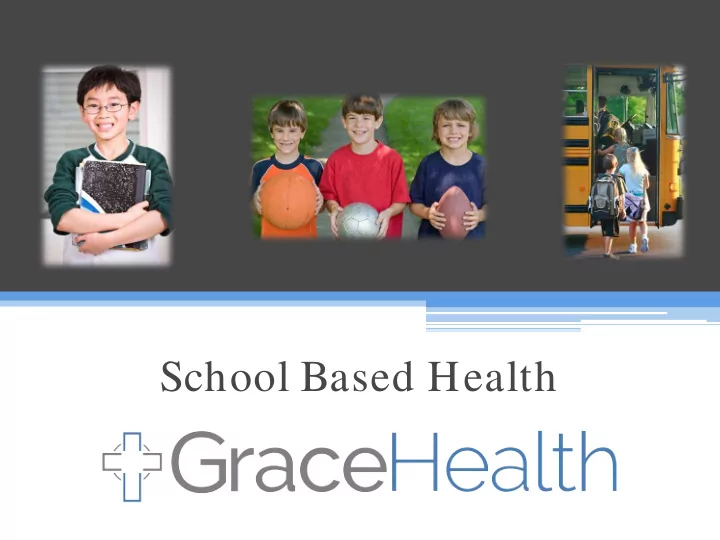

School Based Health
Our Mission: To show the love and share the truth of Jesus Christ to southeastern Kentucky, through access to compassionate, high quality, primary health care for the whole person.
Grace Health School-Based Health • School-based services are provided in 38 school- based health centers • Provide school-based health in: ▫ Bell County Public Schools ▫ Clay County Public Schools ▫ Knox County Public Schools ▫ Leslie County Public Schools ▫ Corbin Independent School District
Grace SBHC Services • Nurses *RN or LPN) on site at each school every day • Rotating nurse practitioner on site • Primary Care ▫ Preventive care (well child visits etc) ▫ Treatment for acute illnesses (cuts, headaches, cough, sore throat, fever etc.) ▫ Manage chronic conditions like diabetes • Dental • State of the art telehealth program • Vaccines/ immunizations • Health education
Grace Health SBHC Services • Address emergencies like seizures, anaphylactic reactions, asthma exacerbations, head injuries, broken bones etc • Sports physicals • Referrals • Coordinated care with other providers • Order labs, x-rays and other outpatient diagnostic procedures • Kentucky HEALTH and Marketplace assisters to assist uninsured children and staff
Grace Health SBHC Services • Enrollment at schools with our SBHC: 15,60 0 • Saw patients in more than 46,0 0 0 visits
Why School-Based Health? • High need in the community ▫ 70.9% children eligible for free/ reduced lunch ▫ 10.4% households have no vehicle No access to a vehicle in a very rural area causes many barriers ▫ 42.4% of the population on Medicaid ▫ 40.9% children live in poverty
Why School-Based Health? • Access to healthcare providers is limited ▫ 38 dentists per 100,000 population (compared to 61.8 per 100,000 across the state) ▫ 47.6 primary care providers per 100,000 population (compared to 74 across the state) • For many students, the provider they see at school is the only access to healthcare they have
Why School-Based Health? • High need for health care: ▫ Poor health: 30.0% ▫ Poor dental health: 33.1% ▫ Asthma: 18.4% ▫ Diabetes: 13.1% ▫ Heart disease: 11.7% ▫ High blood pressure: 37.7% ▫ Obesity: 38.2% • By providing care early, we can prevent serious conditions from developing
Health Outcomes Heart Disease Drug Lung Prem ature Mortality Poisoning Disease Death Rate (per 10 0 ,0 0 0 ) ( per (per (per 10 0 ,0 0 0 ) 10 0 ,0 0 0 ) 10 0 ,0 0 0 ) Service 264 38 .4 8 1.5 12,549 Area National 168 .2 15.6 41.3 7,222
Why School-Based Health? • Health care safety net • Enable children with acute or chronic illnesses to attend school and improve their overall health and wellness through health screenings, health promotion, and disease prevention activities.
Why School-Based Health? • Results - decrease in non-urgent emergency department visits (Young, D’Angelo, & Davis 2001). • SBHCs increases preventative screens (Jones & Clark 1997) • Schools with SBHCs have lower hospitalization rates for asthma (Webber et al. 2003) • Decreases absenteeism (McCord et al. 1993) • Improves drop out rate (McCord et al. 1993)
Our Model • Age-appropriate services focus on: ▫ Prevention ▫ Early intervention ▫ Immediate or urgent need (while avoiding expensive forms of care like the emergency department.
Access to Care • Children with the greatest unmet need, including uninsured students, benefit most from SBHC services. • SBHCs have significant ability to reduce health care access disparities.
USDA DLT Grants ▫ Grace Health 2011 (3 year project) Basic Telehealth Equipment Funding $100,000 Project 15% Match
USDA DLT Grants ▫ Partnership with Baptist Health Corbin 2016 Mobile Telehealth Carts 10 School Based Health Sites ▫ Behavioral Health
USDA DLT Grants ▫ Grace Health 2018 Telehealth Equipment Funding $649,866 includes $153,786 7 Clinics Sites 8 School Based Health Sites 6 Nursing Home Sites 1 LTAC Site
References • Jones, M.E. & Clark, D. (1997). Increasing access to health care: A study of pediatric nurse practitioner outcomes in a school-based clinic. The Journal of Nurse Care and Quality, 11 (4): 52-59 • McCord, M.T., Klein, J.D., Foy, J.M., Fothergill, K. (1993) The impact of school-based health center use on academic outcomes. The Journal of Adolescent Health, 46 (3): 251-257. • Young, T.L., D’Angelo, S.L, Davis, J. (2001) Impact of a school- based health center on emergency department use by elementary school students. Journal of School Health , 71(5): 196-198 • Webber, M., Carpiniello, K., Oruwariye, T, Yungtai, L., Burton, W., & Appel, D.K. (2003). Burden of asthma in inner-city elementary school children: Do school-based health centers make a difference? Archives of Pediatrics and Adolescent Medicine, 157 (2): 125-129
Recommend
More recommend